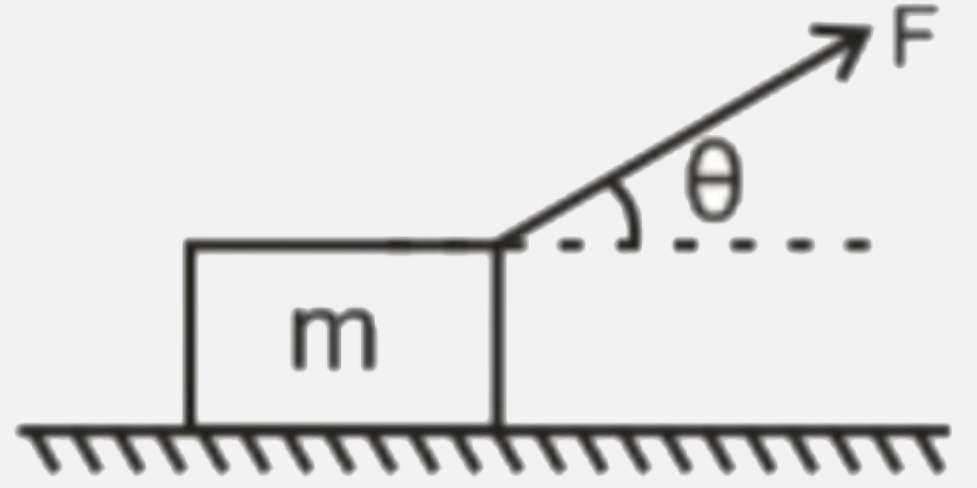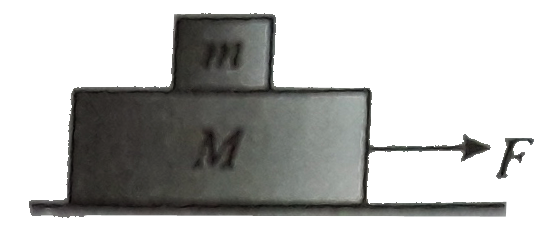A block of mass 'm' is placed on the floor of a lift, moving upward with an uniform acceleration a = g. (μis the coefficient of friction between block and the floor of lift). If a horizontal force of umg acts on the block, then horizontal acceleration of the body is .......
2
6
8
Zero
The correct Answer is:D
To solve the problem, we need to analyze the forces acting on the block in the lift that is moving upward with an acceleration equal to g. Let's break down the steps:
1. Identify the Forces Acting on the Block:
- The gravitational force acting downward: Fg=mg.
- The normal force N acting upward from the lift floor.
- A pseudo force Fp acting downward due to the upward acceleration of the lift, which is equal to ma=mg (since a=g).
- A horizontal force Fh=μmg acting on the block.
2. Calculate the Normal Force:
- Since the lift is accelerating upward, the normal force N must balance both the weight of the block and the pseudo force:
N=mg+Fp=mg+mg=2mg
3. Determine the Maximum Static Friction:
- The maximum static friction Fmaxs can be calculated using the normal force:
Fmaxs=μN=μ(2mg)=2μmg
4. Compare the Horizontal Force with Maximum Static Friction:
- The horizontal force acting on the block is Fh=μmg.
- We need to check if this force exceeds the maximum static friction:
Fh=μmg<Fmaxs=2μmg
- Since Fh is less than Fmaxs, the block will not slip.
5. Determine the Net Force and Acceleration:
- Since the block does not slip, the static friction force Fs will adjust to match the horizontal force Fh:
Fs=Fh=μmg
- The net force in the horizontal direction is:
Fnet=Fh−Fs=μmg−μmg=0
- Therefore, the horizontal acceleration a of the block is:
a=Fnetm=0m=0
Final Answer:
The horizontal acceleration of the body is 0.
---
- The gravitational force acting downward: Fg=mg.
- The normal force N acting upward from the lift floor.
- A pseudo force Fp acting downward due to the upward acceleration of the lift, which is equal to ma=mg (since a=g).
- A horizontal force Fh=μmg acting on the block.
- Since the lift is accelerating upward, the normal force N must balance both the weight of the block and the pseudo force:
N=mg+Fp=mg+mg=2mg
- The maximum static friction Fmaxs can be calculated using the normal force:
Fmaxs=μN=μ(2mg)=2μmg
- The horizontal force acting on the block is Fh=μmg.
- We need to check if this force exceeds the maximum static friction:
Fh=μmg<Fmaxs=2μmg
- Since Fh is less than Fmaxs, the block will not slip.
- Since the block does not slip, the static friction force Fs will adjust to match the horizontal force Fh:
Fs=Fh=μmg
- The net force in the horizontal direction is:
Fnet=Fh−Fs=μmg−μmg=0
- Therefore, the horizontal acceleration a of the block is:
a=Fnetm=0m=0
The horizontal acceleration of the body is 0.
Similar Questions
A block of mass 1 kg is placed on a truck which accelerates with acceleration 5ms−2. The coefficient of static friction between the block and truck is 0.6. The frictional force acting on the block is
View SolutionA block is kept on a rough horizontal surface as shown. Its mass is 2 kg and coefficient of friction between block and surface (μ)=0.5. A horizontal force F is acting on the block. When

View SolutionA block of mass 1 kg is pressed against a wall by applying a horizontal force of 10N on the block. If the coefficient of friction between the block and the wall is 0.5, magnitude of the frictional force acting on the block is
View SolutionA block of mass'm' is resting on the floor of a lift. The coefficient of friction between the block and the floor is μ. When the lift is falling freely, the limiting frictional force between block and surface is
View SolutionA block of mass m is moving on a rough horizontal surface. μ is the coefficient of kinetic friction between the block and the surface. What is the net force exerted by the surface on the block?
View SolutionA block of mass m is placed at rest on an inclination θ to the horizontal. If the coefficient of friction between the block and the plane is μ, then the total force the inclined plane exerts on the block is
View SolutionA block of mass 0.1 kg is held against a wall applying a horizontal force of 5 N on the block. If the coefficient of friction between the block and the wall is 0.5, the magnitude of the frictional force acting on the block is :
View SolutionA wooden block of mass m resting on a rough horizontal table is pulled by a force F as shown in the figure. If μ is the coefficient of friction between block and table, its acceleration will be

View SolutionA block of mass 0.1 is held against a wall applying a horizontal force of 5N on block. If the coefficient of friction between the block and the wall is 0.5, the magnitude of the frictional force acting on the block is:
View SolutionA block of massm is placed on another block of mass M which itself is lying on a horizontal surface .The coefficient of friction between two blocks is μ1and that between the block of mass M and horizontal surfece is μ2 What maximum horizontal force can be applied to the lower block move without separation?

View Solution
